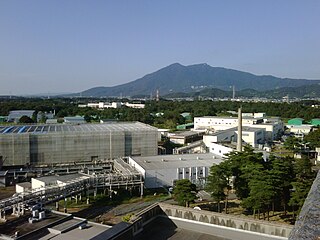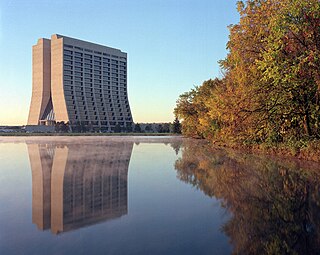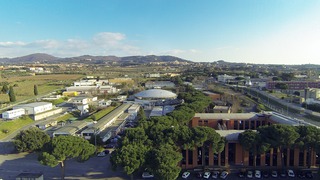Related Research Articles

Particle physics or high-energy physics is the study of fundamental particles and forces that constitute matter and radiation. The field also studies combinations of elementary particles up to the scale of protons and neutrons, while the study of combination of protons and neutrons is called nuclear physics.

The European Organization for Nuclear Research, known as CERN, is an intergovernmental organization that operates the largest particle physics laboratory in the world. Established in 1954, it is based in Meyrin, western suburb of Geneva, on the France–Switzerland border. It comprises 23 member states. Israel, admitted in 2013, is the only non-European full member. CERN is an official United Nations General Assembly observer.

Fermi National Accelerator Laboratory (Fermilab), located in Batavia, Illinois, near Chicago, is a United States Department of Energy national laboratory specializing in high-energy particle physics.

The Large Hadron Collider (LHC) is the world's largest and highest-energy particle collider. It was built by the European Organization for Nuclear Research (CERN) between 1998 and 2008 in collaboration with over 10,000 scientists and hundreds of universities and laboratories across more than 100 countries. It lies in a tunnel 27 kilometres (17 mi) in circumference and as deep as 175 metres (574 ft) beneath the France–Switzerland border near Geneva.
A collider is a type of particle accelerator that brings two opposing particle beams together such that the particles collide. Colliders may either be ring accelerators or linear accelerators.

The High Energy Accelerator Research Organization, known as KEK, is a Japanese organization whose purpose is to operate the largest particle physics laboratory in Japan, situated in Tsukuba, Ibaraki prefecture. It was established in 1997. The term "KEK" is also used to refer to the laboratory itself, which employs approximately 695 employees. KEK's main function is to provide the particle accelerators and other infrastructure needed for high-energy physics, material science, structural biology, radiation science, computing science, nuclear transmutation and so on. Numerous experiments have been constructed at KEK by the internal and international collaborations that have made use of them. Makoto Kobayashi, emeritus professor at KEK, is known globally for his work on CP-violation, and was awarded the 2008 Nobel Prize in Physics.

The Collider Detector at Fermilab (CDF) experimental collaboration studies high energy particle collisions from the Tevatron, the world's former highest-energy particle accelerator. The goal is to discover the identity and properties of the particles that make up the universe and to understand the forces and interactions between those particles.

The Proton Synchrotron is a particle accelerator at CERN. It is CERN's first synchrotron, beginning its operation in 1959. For a brief period the PS was the world's highest energy particle accelerator. It has since served as a pre-accelerator for the Intersecting Storage Rings (ISR) and the Super Proton Synchrotron (SPS), and is currently part of the Large Hadron Collider (LHC) accelerator complex. In addition to protons, PS has accelerated alpha particles, oxygen and sulfur nuclei, electrons, positrons, and antiprotons.
T2K is a particle physics experiment studying the oscillations of the accelerator neutrinos. The experiment is conducted in Japan by the international cooperation of about 500 physicists and engineers with over 60 research institutions from several countries from Europe, Asia and North America and it is a recognized CERN experiment (RE13). T2K collected data within its first phase of operation from 2010 till 2021. The second phase of data taking is expected to start in 2023 and last until commencement of the successor of T2K – the Hyper-Kamiokande experiment in 2027.
The High Luminosity Large Hadron Collider is an upgrade to the Large Hadron Collider, operated by the European Organization for Nuclear Research (CERN), located at the French-Swiss border near Geneva. From 2011 to 2020, the project was led by Lucio Rossi. In 2020, the lead role was taken up by Oliver Brüning.

The LHCf is a special-purpose Large Hadron Collider experiment for astroparticle physics, and one of nine detectors in the LHC accelerator at CERN. LHCf is designed to study the particles generated in the forward region of collisions, those almost directly in line with the colliding proton beams.

The electron machine with many applications or electron model for many applications (EMMA) is a linear non-scaling FFAG particle accelerator at Daresbury Laboratory in the UK that can accelerate electrons from 10 to 20 MeV. A FFAG is a type of accelerator in which the magnetic field in the bending magnets is constant during acceleration. This means the particle beam will move radially outwards as its momentum increases. Acceleration was successfully demonstrated in EMMA, paving the way for future non-scaling FFAGs to meet important applications in energy, security and medicine.
A Fixed-Field alternating gradient Accelerator is a circular particle accelerator concept that can be characterized by its time-independent magnetic fields and the use of alternating gradient strong focusing.
A Muon Collider is a proposed particle accelerator facility in its conceptual design stage that collides muon beams for precision studies of the Standard Model and for direct searches of new physics. Muons belong to the second generation of leptons, they are typically produced in high-energy collisions either naturally or artificially. The main challenge of such a collider is the short lifetime of muons.

The INFN National Laboratory of Frascati (LNF) was founded in 1954 with the objective of furthering particle physics research, and more specifically to host the 1.1 GeV electrosynchrotron, the first accelerator ever built in Italy. The Laboratory later developed the first ever electron-positron collider: from the first prototype AdA, which demonstrated the feasibility, to the ring ADONE and later on to DAΦNE, still operative today (2022). LNF was also the proposed site of the cancelled particle accelerator SuperB.
SuperKEKB is a particle collider located at KEK (High Energy Accelerator Research Organisation) in Tsukuba, Ibaraki Prefecture, Japan. SuperKEKB collides electrons with positrons at the centre-of-momentum energy close to the mass of the Υ(4S) resonance making it a second-generation B-factory for the Belle II experiment. The accelerator is an upgrade to the KEKB accelerator, providing approximately 40 times higher luminosity, due mostly to superconducting quadrupole focusing magnets. The accelerator achieved "first turns" (first circulation of electron and positron beams) in February 2016. First collisions occurred on 26 April 2018. At 20:34 on 15 June 2020, SuperKEKB achieved the world’s highest instantaneous luminosity for a colliding-beam accelerator, setting a record of 2.22×1034 cm−2s−1.

]

FASER is one of the nine particle physics experiments in 2022 at the Large Hadron Collider at CERN. It is designed to both search for new light and weakly coupled elementary particles, and to detect and study the interactions of high-energy collider neutrinos. In 2023, FASER and SND@LHC reported the first observation of collider neutrinos.
An accelerator neutrino is a human-generated neutrino or antineutrino obtained using particle accelerators, in which beam of protons is accelerated and collided with a fixed target, producing mesons which then decay into neutrinos. Depending on the energy of the accelerated protons and whether mesons decay in flight or at rest it is possible to generate neutrinos of a different flavour, energy and angular distribution. Accelerator neutrinos are used to study neutrino interactions and neutrino oscillations taking advantage of high intensity of neutrino beams, as well as a possibility to control and understand their type and kinematic properties to a much greater extent than for neutrinos from other sources.
The Snowmass Process is a particle physics community planning exercise sponsored by the Division of Particles and Fields of the American Physical Society. During this process, scientists develop a collective vision for the next seven to ten years for particle physics research in the US.
References
- ↑ "FrontPage/GeneralInfo". IDS Wiki.
- ↑ Choubey, S.; Gandhi, R.; Goswami, S.; Berg, J. S.; Fernow, R.; Gallardo, J. C.; Gupta, R.; Kirk, H.; Simos, N. (2011-10-01). Interim Design Report for the International Design Study for a Neutrino Factory (Report). Fermi National Accelerator Lab. (FNAL), Batavia, IL (United States).
- ↑ Baussan, E.; Blennow, M.; Bogomilov, M.; Bouquerel, E.; Caretta, O.; Cederkäll, J.; Christiansen, P.; Coloma, P.; Cupial, P.; Danared, H.; Davenne, T.; Densham, C.; Dracos, M.; Ekelöf, T.; Eshraqi, M. (2014). "A very intense neutrino super beam experiment for leptonic CP violation discovery based on the European spallation source linac". Nuclear Physics B. 885: 127–149. doi:10.1016/j.nuclphysb.2014.05.016. ISSN 0550-3213.
- ↑ Delahaye, J.-P.; Ankenbrandt, C. M.; Bogacz, S. A.; Huber, P.; Kirk, H. G.; Neuffer, D.; Palmer, M. A.; Ryne, R.; Snopok, P. V. (2018). "The NuMAX Long Baseline Neutrino Factory concept". Journal of Instrumentation. 13 (06): T06003. doi:10.1088/1748-0221/13/06/T06003. ISSN 1748-0221.
- ↑ Bogacz, Alex; Brdar, Vedran; Bross, Alan; de Gouvêa, André; Delahaye, Jean-Pierre; Huber, Patrick; Hostert, Matheus; Kelly, Kevin J.; Long, Ken (2022-03-15). The Physics Case for a Neutrino Factory (Report). Fermi National Accelerator Lab. (FNAL), Batavia, IL (United States); Brookhaven National Lab. (BNL), Upton, NY (United States); Thomas Jefferson National Accelerator Facility (TJNAF), Newport News, VA (United States).
- ↑ "International Design Study".
- ↑ "UK Neutrino Factory Homepage". Archived from the original on 2005-03-25. Retrieved 2005-05-27.
- ↑ "MUON1 distributed computing project for design work on the UK device".
- ↑ "Muon Accelerator Program (MAP)". fnal.gov. Fermilab. 20 April 2018. Retrieved 14 May 2019.
- ↑ "Homepage". Japan: Fixed Field Alternating Gradient Accelerator. Archived from the original on 2005-04-15. Retrieved 2005-05-27.
- ↑ "Neutrino Research at KEK". Tsukuba, Ibaraki, Japan: High Energy Accelerator Research Organization, KEK.